Books by Peter Higginbotham
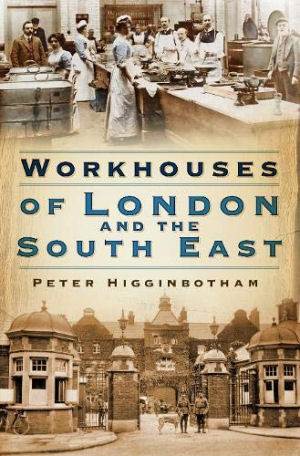
If there is a date at which the workhouse could be said to have been born, a contender would be 1546 — the year Henry VIII handed over the former Greyfriars Monastery, on London's Newgate Street, to the City of London to be used for the relief of the poor. Over the next four centuries, the workhouse became what is often regarded as Britain's most despised and feared institution. Over that time, however, it evolved enormously, and generally for the better. After 1900, for example, the workhouse dinner menu could include such dishes as Irish stew, shepherd's pie, and roley-poley pudding. In the case of medical care, by the early 1900s, some of London's workhouse infirmaries were among the best hospitals in the country. When Health Minister Nye Bevan officially launched the NHS on 5 July 1948, the location chosen for this momentous occasion was a former workhouse infirmary.
Workhouses of London and the South East provides a comprehensive and copiously illustrated guide to the workhouses that were set up across London and the neighbouring counties of Middlesex, Kent, Surrey, Sussex and Berkshire. As well as looking at life for those inside the institution, it traces the devlopment of workhouse buildings, which were often designed by leading architects of the day, including such figures as Sir George Gilbert Scott. The book also details the location of hundreds of workhouse buildings, allowing their development to be tracked on old maps. The book includes a great deal of information not on the website.
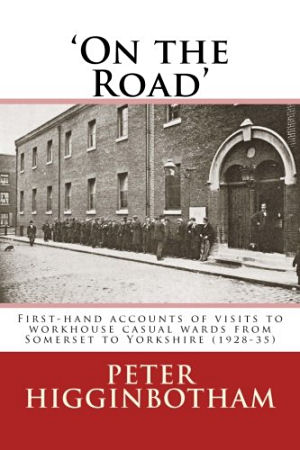
'On the Road' makes available again three collections of first-hand accounts of visits to the casual wards of 50 English workhouses in 1928 and 1935. The diaries' revelations about the often miserable treatment of the inmates of these institutions led to material improvements in conditions, with reform campaigner Mary Higgs contributing a final article to the original series. The book also includes an illustrated history of the casual ward by Peter Higginbotham.
Casual wards visited: Amesbury, Axbridge, Aylesbury, Beaminster, Blandford, Boston, Bridgwater, Bridport, Brigg, Cambridge, Chard, Chatteris, Chippenham, Christchurch, Devizes, Dorchester, Ely, Fordingbridge, Frome, Goole, Grimsby, Hemel Hempstead, Hitchin, Holbeach, Horncastle, King's Lynn, Luton, March, Oxford, Pewsey, Poole, Reading, Ringwood, Royston, Salisbury, Shaftesbury, Shepton Mallet, Sherborne, St. Albans, Sturminster Newton, Thame, Thorne, Wallingford, Wareham, Warminster, Watford, Weymouth, Wisbech, Yeovil, York.
“We arrived, after a walk of about a dozen miles or thereabouts. No application to police again. Found small ward crowded with casuals, the ages varying from 19 to 65 — about twenty altogether. One had lost left arm in France, he told me, and had no pension. He did not give the reason for this. Had a bath! One bathroom for all. Three in room stripped naked for a bath at the same time, and another in it. It was done for quickness owing to the large number, but it was very unpleasant indeed! Towels wet. Shirt given, but not absolutely clean. Slept in cell with floor of wood blocks, with bed-frame and straw mattress and two blankets. No pillow — used boots for that — very uncomfortable indeed.”
Available from Amazon UK. A Kindle edition is also available.
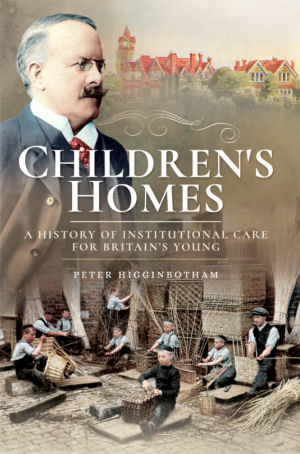
Children's Homes surveys the wide range of institutions that were used as a substitute for children's 'natural' homes. This includes not only orphanages but a wide range of other establishments run by particular bodies (charities, religious groups, workhouse authorities, occupational groups, local councils, single individuals etc.) or which served particular purposes (penal confinement, moral protection, special training etc). Now, there is much evidence that some children's institutions were indeed fearful places where children were, at least by present-day standards, badly treated – even if it was often with the best of intentions by those who ran those establishments.
From the Tudor times to the present day, this fascinating book answers questions such as: Who founded and ran all these institutions? Who paid for them? Where have they all gone? What was life like for their inmates? And where can their records be found? Illustrated throughout, Children's Homes provides an essential account of the previously neglected history of these British institutions.
Paperback, 310 pages. Published July 2017 by Pen and Sword at £14.99. ISBN 978-1526701350 — Place an order with your local bookseller or online at Waterstones UK or Amazon UK. Kindle/ebook also available.
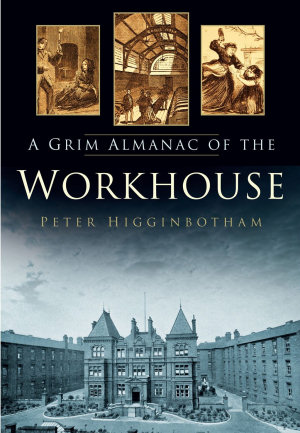
A Grim Almanac the Workhouse looks at the darker side of the workhouse through a day-by-day calendar of grisly and gruesome tales of murders, suicides, fires, drownings, explosions, disasters, abuse, assault, bodysnatching, poisonings and post mortems. Accompanied by seventy wonderful illustrations, this book will thrill, fascinate, sadden and unnerve in equal measure. For example:
5 October 1838 Some inmates at the Greenwich workhouse were removing some oakum from in front of an understairs cupboard when they became aware of a sickening smell emanating from inside. On opening the cupboard doors, they discovered the body of Thomas Robinson, a pauper who had been missing for ten days. It was in an advanced state of decomposition. The head was lying on a coil of rope with a large pool of blood underneath, and was nearly severed from the body. Nearby was a 6-inch razor with which the act had been committed.
Paperback, 192 pages. Published 8th February 2013 by The History Press at £12.99. ISBN 978-0752487397 — Place an order with your local bookseller or online at Amazon UK.

Voices from the Workhouse tells the real inside story of the workhouse — in the words of those who experienced the institution at first hand, either as inmates or through some other connection with the institution such as being staff, administrators, inspectors, visitors, or even under-cover journalists and 'social explorers'. Using a wide variety of sources — letters, poems, graffiti, autobiography, inspection reports, testimony at official inquiries, and oral history, the book creates a vivid portrait of what really went on behind the doors of the workhouse — all the sights, sounds and smells of the place, and the effect it had on those whose lives it touched. Was the workhouse the cruel and inhospitable place as which it's often presented, or was there more to it than that? This book lets those who knew the place provide the answer.
An exclusive in the book is the unmasking of the author of the Victorian workhouse exposé Indoor Paupers published anonymously in 1885. The identity of the writer and of the unnamed London workhouse he describes are finally revealed!
Paperback, 224 pages. Published 22nd October 2012 by The History Press at £12.99. ISBN 978-0752467498 — Place an order with your local bookseller or online at Amazon UK.
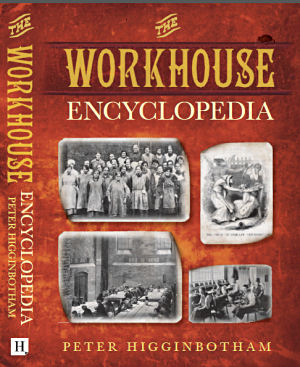
Where was my local workhouse? What records did they keep? What is gruel and is it really what inmates lived on? How did you get out of a workhouse? What famous people were once workhouse inmates? Are there any workhouse buildings I can visit? If these are the kinds of questions you've ever wanted to know the answer to, then The Workhouse Encyclopedia is the book for you.
This fascinating, fully illustrated volume is the definitive guide to every aspect of the workhouse and of the poor relief system in which it played a pivotal part. This A-Z cornucopia covers everything from the 1725 publication An Account of Several Work-houses to the South African Zulu admitted to Fulham Road Workhouse in 1880. Amongst the comprehensive and fact-filled appendices are the complete text of the official 1847 workhouse rule-book, and a directory of the locations and other details of hundreds of workhouses and associated institutions across the British Isles. With hundreds of fascinating anecdotes, plus vital information for researchers such as useful websites and archive repository details, maps, plans, original workhouse publications and an extensive bibliography, The Workhouse Encyclopedia will delight family historians and general readers alike.
Please note that The Workhouse Encylopedia includes a large amount of material not available on the author's workhouse website.
Paperback, 480 pages. Published June 2014 by The History Press at £16.99. ISBN 978-0-7524-7012-2 — Place an order with your local bookseller or online at Amazon UK.

Life in a Victorian Workhouse is a very readable, concise and beautifully illustrated history of the workhouse system, particularly focusing on the Victorian period, and provides an ideal introduction to the subject. Includes sections on the origins of the institution, workhouse buildings, entering and leaving the workhouse, the daily routine, workhouse labour, workhouse food, children, the elderly, medical care, old age and death, tramps and vagrants, workhouse staff, the workhouse in Scotland and Ireland, the workhouse in art and literature. There is also a glossary, timeline, and a list of workhouse museums etc. to visit.
Published May 2011 by Pitkin at £4.99. ISBN 978-0-7524-5423-8 —
Available from your local bookseller or online from
Amazon UK
.

The Prison Cookbook is a unique volume exploring the history of the English prison system — and more especially its food — from the Middle Ages through to the 21st century. Prison cuisine has a surprisingly varied history. Until the 19th century, prisoners were expected to pay for their own board and lodging whilst inside. For some, this meant little hardship — Anne Seymour, imprisoned in the Tower of London in 1551, enjoyed a midday dinner of mutton stewed with pottage, boiled beef, roast veal, roast capon and two rabbits. For many though, especially debtors, prison food was often little more than bread and water — if they were lucky. In more recent times, there has been a periodic outcry over the 'feasts for beasts' served to convicted murderers and sex attackers at Christmas-time. As well as period recipes for long-forgotten dishes such as panada, burgoo and brewis, the book includes a complete facsimile reproduction of the official Manual of Cooking & Baking for the Use of Prison Officers published in 1902 at Parkhurst prison.
The book's broader history of prisons takes in: ancient London gaols such as Newgate, Marshalsea, the Clink, and the Fleet; the transportation of criminals to America and Australia; the opening of prisoner of war prisons such as Dartmoor; Jeremy Bentham's ill-fated 'panopticon'; the creation of the first national penitentiary at Millbank and the 'model' prison at Pentonville; and the nationalisation of the prison system in 1877 which saw the closure of dozens of small local gaols.
Published May 2010 by The History Press at £12.99. ISBN 978-0-7524-5423-8 — Available from your local bookseller or online from Amazon UK.
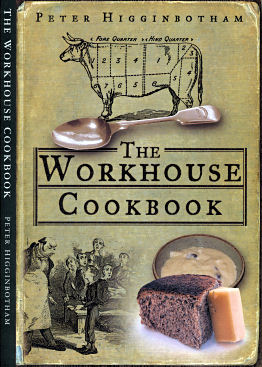

(Above - the Workhouse Cookbook being featured on BBC1's Sunday Life programme.)
This fascinating book explores every aspect of living and eating in the workhouse. Packed with photos, recipes, and dietary tables, and a complete reprint of the official 1901 Manual of Workhouse Cookery, it is a shocking, surprising and unique guide to the workhouse and its cuisine.
The Cookbook is an antidote to Dickens' grim picture of malnourished workhouse inmates existing on watery gruel. At times in the history of the workhouse, the fare included such items as beer, chocolate, cheesecake, and nettles!
The book uncovers many other facets of workhouse life, such as surreptitious liaisons between male and female inmates, the lonely miner who wrote to his local workhouse for a wife, and the day 600 elderly Camberwell workhouse residents had a drunken seaside outing to Bognor Regis...
With sections on workhouse kitchens and cooks, diets for children, the elderly and the sick, life in Scottish and Irish institutions, and Christmas Day in the workhouse —; including how to make Christmas Pudding for 300 — this book will be enjoyed by cooks, epicureans, and lovers of history everywhere.
Published August 2008 by Tempus Publishing at £12.99. ISBN 978-0-7524-4730-8 — Place an advance order with your local bookseller or online from Amazon UK.
"All aspects of life are touched on in this wonderful book, which provides a well-balanced picture of the hardships - and occasional comforts - of the workhouse." (Your Family Tree, March 2009)
"There has been a bit of fuss about olde-worlde eating on the telly of late. Thus with The Workhouse Cookbook, Peter Higginbotham is truly riding the zeitgeist. Add the fact that Oliver! The musical, workhouse dining's artistic high point is currently tearing up the West End, and Higginbotham practically is the zeitgeist" (World of Interiors, May 2009)
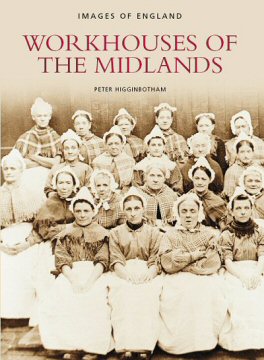
Contents include:
- A history of the poor law and evolution of the workhouse, particularly focusing on the English Midlands
- Over 100 illustrations, including many rare vintage images
- A county-by-county gazetteer of the poor law unions in Derbyshire, Leicestershire, Lincolnshire, Northamptonshire, Nottinghamshire, Oxfordshire, Rutland, Staffordshire, Warwickshire, and Worcestershire
- Poor law union maps and National Grid references to help locate workhouse sites via printed maps or mapping sites such as Multimap
- A guide to workhouse records and where they can be located
Published September 2007 by Tempus Publishing at £12.99. ISBN 0752444883 — Order from your local bookseller or online from Amazon UK.
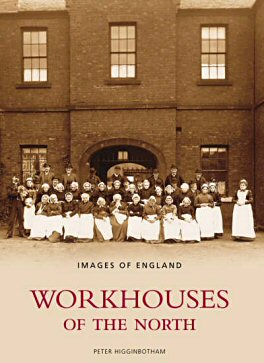
Contents include:
- A history of the poor law and evolution of the workhouse, particularly focusing on northern England
- Over 120 illustrations, including many rare vintage images
- A county-by-county gazetteer of the poor law unions in Cumberland, Durham, Lancashire, Northumberland, Westmorland, and Yorkshire
- Poor law union maps and National Grid references to help locate workhouse sites via printed maps or mapping sites such as Multimap
- A guide to workhouse records and where they can be located
Published July 2006 by Tempus Publishing at £12.99. ISBN 0752440012 — Order from your local bookseller or online from Amazon UK.
Except where indicated, this page () © Peter Higginbotham. Contents may not be reproduced without permission.


